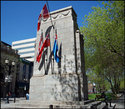
Beasley
Beasley is bounded by James Street North to the west, the CN Rail line to the north, Wellington Street to the east and Main Street to the South.
This neighbourhood was named after Richard Beasley, one of the original settlers at the Head-of-the-Lake. It is one of Hamilton's four downtown neighbourhoods.
The most notable feature of Beasley is Gore Park and the Gore commercial area. The Gore was once the hub of commercial activity in Hamilton but has been in decline since the rise of the mall and the suburbs in the 1960s.
Beasley was also home to many of Hamiltons first industries.

Black Forest Inn
An awesome German restaurant.

Catharine and Cannon Building
This Beasley light industrial building is the now the office of McCallum Sather Architects.

Century (Lyric) Theatre
The 2300-seat Lyric Theatre opened in 1913 as a vaudeville and motion-picture house. It closed in 1989, but as of March 2009 the building still stands.

Christs Church Cathedral
Christ's Church Cathedral is located on James Street North in the Beasley Neighbourhood. The current building is the second church to stand in this location and was built between 1853 and 1875.

Christs Church Cemetery
Located behind Christ's Church Cathedral. This cemetery was active between 1837 and 1853. Most of the graves have been moved to Hamilton Municipal Cemetery

Ferguson Avenue Shul
The Ferguson Avenue shul, known as the "Broigasa Shul", was called the angry shul. If somebody couldn't get along with people in their shul, they went there.

Hamilton Fire Station 1
In 1913 Central Fire Station #1 was erected on John South, complete with a modern fire alarm system. The building was just recently updated and refurbished.

John Weir Foote V.C. Armouries
Various Armoury buildings have stood in this James Street North location since 1887.

Kenesky Sports and Cycle
This building was constructed in 1884. For many years, it has housed Kenesky Sports and Cycle. The worlds first manufactured goalie pads were made here in 1920s by Emil Kenesky.

Landed Banking and Loan Company Building
The Landed Banking and Loan Company Building erected in 1908 was designed by local architect Charles Mills, as a copy of New York City's Knickerbocker Trust and Safe Deposit Bank. It is located on the north east corner of Main and James Streets.

Lister Block
Located on the north east corner of James Street North and King William. The current Lister Block was erected on the site of the old Lister Chambers after the Chambers were ravaged by fire in 1923. The Block closed in 1995.

LIUNA Station
The Hamilton CNR station was built in 1929-1930. This building replaced the previous Stuart Street station which lay further west along the tracks past Bay Street. The station was shut down in 1993.

Oak Hall
Oak Hall was built in 1900. It originally housed a W. E. Sanford and Co. Clothing store and the office of Dr. Crawford.

Oakwood
Oakwood was once the home of the Prime Minister Lester B. Pearson.

Pagoda Restaurant
The "Pagoda" is the oldest continuously operating restaurant in Hamilton. The building is likely Pre-Confederation.

Raich House
In 1845, one year before the City of Hamilton was incorporated, this frame house was built in the Classical-Revival style by brothers Thomas and Peter Fitzpatrick, local carpenters. It is one of the oldest surviving structures in Hamilton.

Royal Connaught Hotel
Located on the south side of King Street East, between John and Catherine. The Royal Connaught Hotel opened in 1916.

St. Johns Evangelical Lutheran Church
This steepled brick edifice was erected in 1882 as St. Paul's Baptist Church, later rededicated as St. Paul's Evangelical Lutheran Church, and finally rededicated as the current St. John's Evangelical Lutheran Church.

Stewart Memorial Church
In 1905 the wooden African Methodist Episcopal Church was rebuilt in brick in the Gothic-Revival style, and renamed Stewart Memorial.

Studholme Memorial Hall
The Hamilton Labour Temple, erected in 1922, was named Studholme Memorial Hall after labour leader Allan Studholme.

Treble Hall
Treble Hall, one of the finest surviving examples of Renaissance Revival style architecture in Hamilton, was designed by James Balfour, and erected in 1879.

William Pring House
William Pring, appointed Surveyor of Customs in 1851, had this house built in 1855 for himself and his family.































